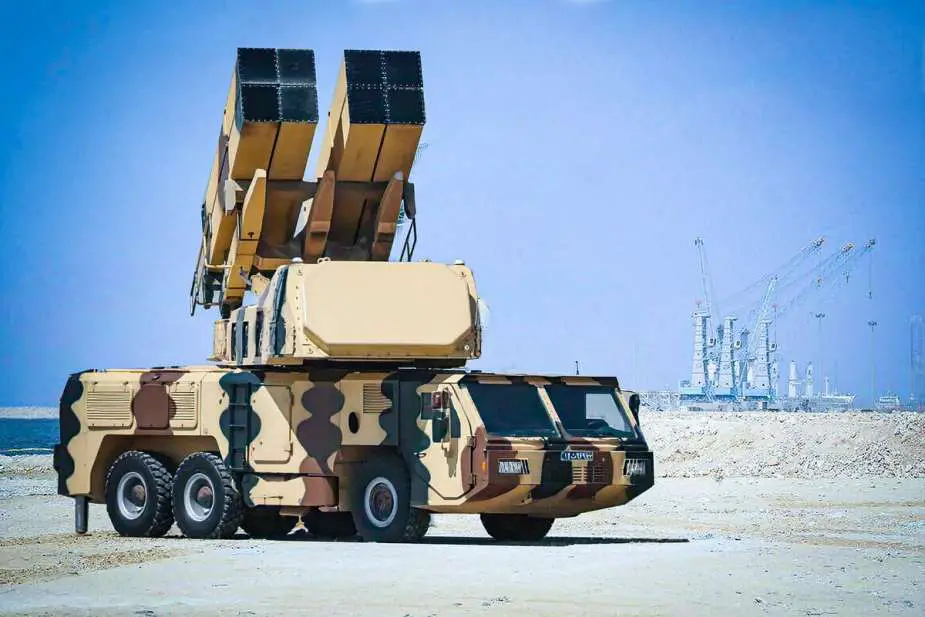Breaking News
Iran Deploys New 9-Dey Air Defense Missile System to Counter US and Israeli Aerial Threats.
The Iranian defense forces are ready to deploy their latest generation of air defense systems, including the 9-Dey, a new type of surface-to-air missile that uses the same 6x6 chassis as the Iranian-made Sevom Khordad road-mobile long-range high-altitude defense missile system. This system is fitted with a new missile launcher equipped with two blocks of four containerized missiles ready to fire. The future deployment of the 9-Dey comes amid rising tensions between Iran and Israel.
Follow Army Recognition on Google News at this link

The 9-Dey is an advanced Iranian surface-to-air missile system designed to intercept and destroy a variety of aerial threats, including fighter jets, drones, and cruise missiles, with a firing from 5 to 30 km and altitude up to 20 km. (Picture source: Iranian ISW website)
The Iranian defense forces continue to enhance its air defense capabilities with the introduction of the new 9-Dey surface-to-air missile system. This short-range air defense system is designed to counter low-flying threats such as cruise missiles, drones,fighter jets , helicopters and munitions dropped from enemy aircraft, making it a crucial addition to Iran's military arsenal.
Unveiled on May 21, 2021, the 9-Dey system represents a significant milestone for the Islamic Revolution Guard Corps (IRGC), which produced the system as part of Iran's broader initiative to modernize its military forces. The unveiling underscored Iran's commitment to advancing its indigenous military capabilities.
The 9-Dey system's combat capabilities were first demonstrated in an exercise dubbed "Defenders of the Sky of Velayat 2023," which took place from November 5 to November 7, 2023. During this exercise, the system successfully intercepted and destroyed several assigned targets, showcasing its effectiveness and precision in engaging modern aerial threats.
Technically, the 9-Dey is a short-range air defense missile system optimized for engaging low-flying targets. It has an effective range of 5 to 30 kilometers and a flight ceiling of 20 kilometers, allowing it to engage a wide range of threats from varying distances and altitudes. Its radar systems are reportedly capable of detecting and engaging multiple aerial threats simultaneously, providing robust early warning and interception capabilities. The system's integration with existing defense systems, such as the Khordad-15, enables a layered defense strategy that enhances the overall resilience and effectiveness of Iran's air defense network. This air defense system is based on the same 6x6 military truck chassis as the Sevom Khordad, an Iranian road-mobile long-range high-altitude defense missile system.
The 9-Dey system differs notably from the Sevom Khordad in its missile launcher configuration. While the Sevom Khordad features a bank of three missiles ready to fire, the 9-Dey employs a unique design consisting of two blocks, each equipped with four containerized missiles. This results in a total of eight missiles ready for deployment, providing enhanced firepower and capacity for sustained operations. Additionally, the 9-Dey system integrates an S-band detection radar mounted at the front of the missile weapon station, improving its target acquisition and engagement capabilities. This configuration enhances the system’s ability to respond rapidly and effectively to various aerial threats.
A key feature of the 9-Dey mobile air defense system is its use of the same radar technology as the Sevom Khordad, mounted at the front of the vehicle. The Sevom Khordad air defense system, a critical component of Iran's integrated air defense network, features a sophisticated S-band phased array radar mounted at the front of the vehicle. This radar is specifically designed for target detection and tracking, providing critical data for missile guidance against various aerial threats, including aircraft, drones, and missiles.
Operating within the 2 to 4 GHz frequency range, the S-band radar offers a detection range of up to 150 kilometers (approximately 93 miles) and is capable of simultaneously tracking multiple targets. This capability is crucial for the system's effectiveness in engaging targets at medium to long ranges and high altitudes. The radar's phased array technology allows for electronic beam steering, enhancing its speed and accuracy in target acquisition and its ability to resist electronic jamming and countermeasures.
The 9-Dey system differs notably from the Sevom Khordad in its missile launcher configuration. While the Sevom Khordad features a bank of three missiles ready to fire, the 9-Dey employs a unique design consisting of two blocks, each equipped with four containerized missiles. This results in a total of eight missiles ready for deployment, providing enhanced firepower and capacity for sustained operations. Additionally, the 9-Dey system integrates an S-band detection radar mounted at the front of the missile weapon station, improving its target acquisition and engagement capabilities. This configuration enhances the system’s ability to respond rapidly and effectively to various aerial threats.
The 9-Dey system shares its 6x6 chassis with the Iranian-made Sevom Khordad road-mobile, long-range, high-altitude defense missile system. This chassis is a locally produced copy of the MZKT-6922, originally manufactured by MZKT and used for the Russian Buk-M2E missile system. By adopting this chassis, Iran emphasizes modularity and mobility, allowing for rapid deployment and operation across diverse terrains.
Iran's version of the 9-Dey system significantly differs from the Belarusian MZKT-6922 model. The Iranian truck is shorter, with the engine mounted at the front rather than the rear, as seen in the Belarusian design. This configuration allows for side access to electronic systems, with different door numbers and shapes compared to the Belarusian counterpart. Additionally, the Iranian model features increased height and two hydraulic jacks between the truck's axles to enhance stability during firing, suggesting improved off-road capability.
The system's mobility is further enhanced by the decision to mount the radar and launchers on a single, mobile platform. This allows the 9-Dey to be rapidly repositioned as needed, making it an ideal solution for defending critical infrastructure and responding to emergent threats. The chassis's design provides the necessary robustness and agility to traverse challenging terrains, ensuring the 9-Dey can operate effectively in a wide range of environments.


























